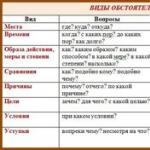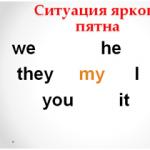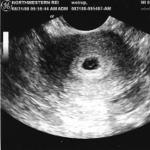Individual speech therapy lesson "sound production w". Bogomolova A.I. Violation of pronunciation in children: a guide for speech therapists
Anya Kuznetsova
Open class"Sound production [w]".
Target: sound setting [w].
Tasks: 1. Clarification of articulation sound [w];
2. Teach isolated pronunciation sound [w];
3. Acquaintance with the letter Ж;
4. Development of phonemic hearing;
5. Development of phonemic analysis;
6. Development of articulatory, general and fine motor skills;
7. Development of attention, memory.
Equipment: mirror, toy - bee, object pictures, schemes for determining the place sound in a word, a guide for breathing exercises, soundtrack, presentation.
Course of the lesson:
1. Organizational moment.
Greetings.
Emotional attitude.
2. Goal setting, message topic.
Speech therapist reads a riddle:
All she buzzes, buzzes
Circles over the flowers.
She sat down, took the juice from the flower
Honey prepares us (bee).
A bee came to our lesson and prepared many interesting tasks.
And how is the bee buzzing?
Can you hum like that?
Today we will learn to pronounce sound [w]... This requires the lips and tongue to work well.
3. Respiratory and articulatory gymnastics.
Speech therapist. There was a bee in the flower meadow. And her name was Zhuzhzhu. She was very funny because she loved to sing songs. Once a bee flies and sees butterflies sitting on flowers. She asks them
Bee Zhuzhzhu. Well, butterflies, what happened to you, why aren't you flying? After all, such a beautiful weather!
Butterflies. We can’t fly, it started to rain and wet our wings.
Bee Zhuzhzhu. Well, poor butterflies, if the wind helped you, only in this weather it won't blow.
Butterflies. What do we do?
Bee Zhuzhzhu. Don't worry, butterflies, my friends will help you. Kolya, let's help the butterflies dry their wings. Blow on the wings of the butterflies and they will dry out.
Speech therapist. You need to take a deep breath with your nose and a slow, long exhale with your mouth.
Breathing exercise "LET'S LET THE BUTTERFLIES": inhale-exhale.
An exercise "SMILE"
Speech therapist. Now let's show how the bee smiled to Buzz to butterflies. (Count from 1 to 10).
Speech therapist. Zhuzhzhu the bee was amused and her tongue jumped up and down. We will swing too.
An exercise "SWING"
Speech therapist. Zhuzhzh the bee wanted to sing a song, but for some reason the tongue did not obey her, let's punish him.
An exercise "WE WILL PREVENT THE INOUTE TONGUE"
The child says five-five-five (Five times).
Speech therapist. Bee Zhuzhzh wanted to drink tea with honey, but there is no cup, let's make a cup.
An exercise "CUP"
Speech therapist. Bee Zhuzhzhu drank tea from a cup and decided to rest. I looked around and saw a fungus growing under the tree. The bee Zhuzhzh decided to lie under it. She smiled at him and made a mushroom tongue with her tongue. Come on and we'll make the fungus.
An exercise "FUNGUS"
Speech therapist. The bee is lying Zhuzhzhu, resting. Suddenly he hears the horse clatter with its hooves. Zhuzhzh the bee wanted to learn how to click with its tongue in the same way.
An exercise "HORSE".
Speech therapist. Our bee got tired and flew to the house, to her friends, bees. And our tongue is also tired, put it on the lower lip, let it rest.
4. Clarification of articulation [g] (in front of the mirror).
The lips are extended forward. (the child repeats.)
Are the teeth closed or open?
Slightly open, there is a small gap between the teeth.
Where is the tip of the tongue?
After each question, the speech therapist shows articulation again sound w, the child also says sound.
The tip of the tongue is raised up, but does not touch upper teeth, the lateral edges are curved and have the shape of a cup.
The speech therapist shows the position of the tongue with a hand.
Show with your hand which tongue?
What does a tongue resemble?
A cup.
5. Sound setting [w].
A) by imitation - from [w].
Let's say sound sh-sh-sh ... now put your hand on my throat, and I on yours, and we will say sound sh with voice... Listen to me.
B) - do "Cup", wind it up by the upper teeth and blow on the tongue with a voice. Sponges with a little window, teeth slightly ajar.
6. Feature sound.
Sound[F] is always a solid, voiced consonant.
7. Reinforcement of isolated utterance sound.
Well done! Now let's turn into bees and fly to the flower meadow. ( "Flies" and "Sits down" on a flower, takes a flower and at this moment emphasizes the last sound w-w-w-w).
8. Development of phonemic hearing.
Let's play a game "Catch sound» ... If you hear sound F - whistle the pipe.
Z-N-S-W-D-Z-Z-H-Z-Z-Z-C-Z-Z
9. Development of phonemic analysis.
A) -The bee has a lot of friends and she decided to split them into 2 teams. In one team there will be only those animals, in the name of which there is sound Ж(giraffe, hedgehog, walrus, lark)... And in the other, no sound Ж(hare, raccoon, dog, lion).
What kind of animals did we choose?
B) Game for the development of attention and memory.
"What changed?"
C) Distribute the pictures under schemes:
(at the beginning, in the middle and at the end of a word).
10. Physics "Bee"
Flew to us yesterday
striped bee (bee in the right hand)
And behind her is a bumblebee - a bumblebee
and a cheerful moth (shift the bee to the left hand)
Two beetles and a dragonfly as eye lanterns (pass the bee around)
Buzzed, flew from fatigue, fell
(lift the bee up, lower it to the floor).
11. Visual gymnastics.
"Little bee"
12. Acquaintance with the letter J.
The bee has a favorite letter - this is the letter J. What do you think it looks like?
Can you recognize the letter Ж among others?
F K X L F S M X
13. Development of fine motor skills.
The bee has come up with something interesting for you the task: laying out a letter from the constructor.
14. Homework.
Help the bee get to the flower, when you lead your finger along the path, you need to hum along with the bee.
15. Summing up.
Who flew to visit us? Which sound did we learn to pronounce? Let's say it again J-J-J.
Surprising moment.
Related publications:
Individual speech therapy lesson "Sound production [L]" Natalia Vasilieva Purpose. Form the initial pronunciation skills of the sound [L]. Tasks. 1. Correctional - training: - Clarify articulation.
Topic: Individual lesson... Setting the sound "L" Objectives: Correctional and educational: - formation correct pronunciation sound [L] ;.
Author-compiler Faustova IA Abstract of an individual speech therapy lesson Topic: Sound [L]. Stage: Sound setting [L], automation.
Synopsis of a speech therapy lesson with deaf children, grade 4 “Autumn. Sound production [w] "
Objectives: -Position the sound of Ш -Develop speech hearing. -Develop speech breathing. -Develop oral speech, enrich the dictionary. -Develop logical.
Summary of the lesson "Setting the sound z" Profile of articulation of sounds [Г] and [Г '] Articulation for sound Г lips - open, in a neutral position; teeth.
Open lesson on self-education in the second junior group. Staging of the Russian folk tale "The Wolf and 7 Kids". Software content. Integration of educational areas: " Cognitive development»(Formation of a holistic picture of the world); “Physical.
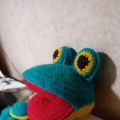 Node theme: Sound [Л]. Stage: Setting the sound [L]. Objectives: 1. Correctional and educational: the formation of the correct pronunciation of the sound [L] ;.
Node theme: Sound [Л]. Stage: Setting the sound [L]. Objectives: 1. Correctional and educational: the formation of the correct pronunciation of the sound [L] ;.
Image library:
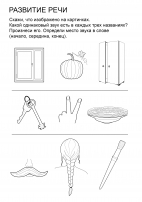
Topic. Sound productionf .
Goals. Development of speech motor skills, phonemic perception andphonemic analysis, clarification of sound articulationwell, sound productionf and consolidation of normal articulation inisolated pronunciation, strengthening the connection of sound andlettersf.
Lesson content
Organizing time.
Topic message.
There are several pictures on the board (beetle, spider, cat). Speech therapist readsriddle:
Zhu-zhu-zhu, zhu-zhu-zhu,
I'm sitting on a branch
I'm sitting on a branch
Letterf I repeat everything.
Knowing firmly this letter,
I hum in the spring and summer.
-
Who is that buzzing on the branch? Find a picture.(Beetle.)
Yes, it's a beetle.
Show the letter the word starts withbeetle.
(Letterf
hanging outon the board.) This letter indicates the soundf.
This sound resembles a buzzbeetle gagging:w-w-w-w.
Today we will learn to make a soundf.
This requires the lips and tongue to work well.
3.
Articulatory gymnastics.
For lips: a smile tube.
For the tongue: make the tongue wide, wide tongue on the upper lip,wide tongue on the lower lip; raise the wide tip of the tongue to the topteeth, lower the wide tip of the tongue to lower teeth, the same forupper teeth, behind lower teeth; make a boat, make a cup outsidemouth, put the cup in the mouth, blow on the cup.
4. Sound productionf. The technique of staging by sound voicing is usedNS.
- Place your hand on the neck. Make a soundNS, now tellmake it loud, so that the throat trembles. It turns out the soundf.
After a long recitation, it is clarified that the beetle is buzzing like that.Children take turns pronouncing this sound. The speech therapist corrects and clarifies the articulation of the sound. In case of difficulty, one hand of the child is appliedit is put to the throat of the speech therapist, the other is placed on the area of the child's larynx. Speech therapistreproduces soundwell, the child imitates using tactile and vibration sensations.
You can use stagingf from the soundh. When making a sounds children are encouraged to lift the tip of the tongue up by the upper teeth.
5. Clarification of sound articulationg. (sound profile f)
Let's say the sound againf. In what position of the lips when pronouncingthe soundwell?
The lips are extended forward. (All children repeat.)
Are the teeth closed or open?
Slightly open, there is a small gap between the teeth.
-Where is the tip of the tongue?
After each question, the speech therapist again shows the articulation of the soundwell, children also make the sound again.
-
The tip of the tongue is raised upwards, but does not touch the upper teeth.
(All children repeat.) The tip of the tongue and side edges are curved and have
cup shape.
The speech therapist shows the position of the tongue with a hand.
- Show with your hand which tongue? (Children show.)
- What does a tongue resemble?
- A cup.
Speech therapist generally describes sound articulationwell, accompanying hermovement of the hand, depicting the shape of the cup. Children repeat.
6. Development of phonemic analysis.
but)Game "Raise the Flag". The speech therapist names the words:toad, desk,
lamp, door, leather, shovel, giraffe, hedgehog.
Children raise a flag
if there is a sound in the wordf.
b)Distribute the pictures. Pictures are displayed on the board: fire,
puddle, jasmine, beetle, toad, skis, pajamas, acorns, jacket. Children shouldus to distribute the pictures into two groups: on the left, put the pictures, inwhose rank the soundf
at the beginning of the word, and on the right are those pictures in the titlewhich soundf
in the middle of a word. At the same time, the speech therapist clearly calls at firstla all the pictures, highlighting the sound with a voicef
in a word.
in)Find the place of soundf
in words. Children have numbers 1, 2, 3. Speech therapist
pronounces words, children determine which sound isf
in the word (lanethird, second or third), and raise the corresponding figure. Approximate words:hot, dinner, yellow, burn, iron, fire, liquid,
plant.
7 . Securing the connection between sound and letterf.
-
Look at the letterf.
What does it resemble, what does it look like?
-On the beetle.
- Fold a letter out of sticksf. And then pick up the pictures, in the namewhich have soundf.
During the independent completion of this task, a speech therapist indievisually deals with those children who have sound articulationf moreinsufficiently secured.
8. Summing up the results of the lesson.
What sound did we learn to pronounce?
Soundf.
How is the sound z pronounced? Children repeat the articulation of soundf.
In children preschool age various speech disorders are often observed. The most common among them violation of pronunciation of sounds, which cannot be considered a harmless defect, because it can lead to negative consequences for the development of the child: difficulty in learning to read and write (dyslexia and dysgraphia), and subsequently to a decrease in academic performance in the Russian language.
Speech should be understandable to others, and if a child pronounces certain sounds of speech incorrectly, then difficulties may arise in communicating with peers and adults. Such a child is often mimicked, so he remains silent, feels self-doubt, which creates additional psychological problems.
Adults should be directly involved in the formation of children's speech, and the sooner the necessary measures are taken to improve speech development the child, the more complete his overall development will be.
A reasonable family always tries to influence the formation of children's speech, starting from the earliest years of life.
The first step in preventing such problems is to contact a speech therapist who will correct the child's speech deficiencies. But, many parents do not seem to care about the absence of sounds [w], [f] in the child's speech even at five years old. They believe that the child will still "speak out", it happens that the parents are very busy or are experiencing financial difficulties (after all, speech therapy is not cheap).
The task of a speech therapist is to help parents in forming the correct pronunciation of sounds, to tell about at what age and where to start work on correcting incorrect pronunciation, why and in what sequence, but provided that your child does not have deviations in the structure of speech organs ( malocclusion, short frenum of the tongue, absence of front teeth, high hard palate).
Of course, the absence of sounds [w], [w] in speech is hard not to notice. They appear later than whistling ([s], [h]) sounds. Is it possible to accelerate their formation and how to avoid defective pronunciation of sounds? Let's try to give the most general answers to these questions.
Hissing sounds are difficult to stage and automate at home. It will take a lot of patience from parents. Sometimes it will seem that all efforts are in vain, and you will not succeed. The main thing is to methodically continue the work begun. But don't overload your child! It is enough to practice twice a day for 10 minutes. Classes are necessarily held in the form of a game - a competition. It will take about a month or more to put and automate these sounds in forward and backward syllables.
What are the violations of the pronunciation of hissing sounds?
What are "sigmatism" and "parasigmatism"?
The lack of pronunciation of all hissing (w, w, h, w) is called sigmatism.
Replacing sound with other sounds (C, T) is called parasigmatism
Variants of incorrect pronunciation of sounds w, z.
There are the following types of sigmatism:
- Interdental - lateral sigmatism- the tip of the tongue falls between the front teeth, and one edge comes off the molars and therefore the entire tongue turns to one side.
- Lateral sigmatism- both edges of the tongue (or one) are torn off from the molars, which forms a gap between the edge of the tongue and the molars. The air rushes into the gap formed, the tip of the tongue rests against the sky, and a squelching sound is obtained.
Labial - dental sigmatism - the lips are pulled forward, the upper incisors are pressed against the lower lip, forming a gap with it, where air rushes. You hear a sound close to F... (B when pronouncing the sound J.)
Buccal sigmatism - the tongue lies passively at the bottom of the mouth, the air swells both cheeks.
Softened sound [w] - obtained with lower articulation or if the tip of the tongue is close to the front teeth.
Nasal sigmatism (nasal) - the soft palate sinks and air enters the nasal cavity.
1. Preparation of the articulation apparatus.
Articulatory gymnastics.
In order for the child to pronounce hissing sounds correctly, it is necessary to prepare a solid base for their appearance. How to do it? You should start work with articulation exercises - exercises for the tongue and lips. In the process of playing, the child must learn to raise the wide tongue to the alveoli, to hold it in this position. Articulation is considered learned if it is performed correctly and does not need visual control.
Before starting to work with a child, you need to know the following rules:
- Perform exercises in front of a mirror, under the account of an adult.
- You can not force the child to study. This should be done in the form of a game that is interesting for the child.
- Each exercise is performed at least five times.
- avoid mentioning the sound you are working on.
Here basic articulation exercises for the successful production of hissing sounds:
1. "Let's punish the naughty tongue" - tongue on the lower lip and, spanking it with your lips, say: "Pa-pa-pa".
2. "Shovel"- open your mouth and put a wide tongue on the lower lip so that it touches the corners of the mouth. Hold in this position for a count of up to 10. The tongue is motionless, calm.
3. "Hide and Seek"- open your mouth wide and close the upper lip with the wide tip of your tongue.
4. "Long tongue"- open your mouth wide and try to reach the tip of your nose with the tip of your tongue.
5. "Swing" - open your mouth, smile broadly. At the expense of "one - two", the tip of the tongue first touches the upper and then the lower lip.
6. "Delicious jam"- the mouth is open, lick the upper lip with a wide tongue and remove the tongue deep into the mouth.
7. "Cup"- open your mouth wide, put a wide tongue on the lower lip, bend the edges of the tongue with a "cup" and slowly lift it by the upper teeth.
By doing these exercises (2 weeks), the child will learn to control his articulatory organs, thoroughly prepare the muscles of the tongue for uttering hissing sounds. For these sounds, the mobility of the articulatory apparatus is very important. Therefore, by all means try to move your lips, tongue, lower jaw!
Pronunciation of sounds with the correct variation.
When pronouncing the sound [w], the lips are extended forward and rounded. The distance between the teeth is 4-5 mm. The tip of the tongue is raised towards the beginning of the hard palate or alveoli, has the shape of a "bucket". The lateral edges of the tongue are pressed against the upper molars; the palatine curtain is raised and closes the passage to the nose. The vocal folds are open; a strong expiratory stream of air passes through two slits: between the back of the tongue and the soft palate, and between the tip of the tongue and hard palate... In this case, a complex noise is produced, lower than when pronouncing sibilants, reminiscent of hiss.
When forming a voiced [w], the same articulation, but a voice is added. The exhaled stream of air is somewhat weaker and the gap between the tip of the tongue and the hard palate is smaller than during the formation of [w].
Sound production techniques[NS] and[f] .
First, the sound [w] is put, and then [w] is put on its base .
1. By imitation: Show your child the correct articulation of the sound [w].
The child opens his mouth, makes a "cup" out of the tongue and leans its edge against the upper incisors. Say that there is hot tea in the "cup", so you need to blow it. The exhalation can be felt on the palm of your hand.
Now the "cup" needs to be "brought" into the mouth: the "edge of the cup" should, without breaking away, slide along the inner side of the upper incisors, then across the palate to the alveoli. The whistling sound will first go to S, then to W. When you hear W, tell the child that this is how the snake hisses.
The child performs all actions according to your soundless display.
2. Statement from sound [s]
Pronounce a long sound (s-s) or syllable CA, at this moment lift the tip of the child's tongue with a spatula or finger for the upper teeth, on the alveoli. The sound Ш or ША is heard. Draw the child's attention to the upper position of the tip of the tongue, invite them to listen to what happened: “I pronounced SA. What happened? "
3. Staging from sound [p]- you need to slow down the vibration of the tip of the tongue with mechanical assistance(with a spatula) or the word "stop!", suggest holding the articulation and remembering the place behind the upper incisors. At "this place" say SA and listen to what happened. When whispered ra is heard sha, and when loud - Ms.
4. In exceptional cases, you can put the lower sound [w], pushing the tip of the tongue back with a spatula, at the time of pronouncing the sound C - c-c.
The sound [W] is usually put from the sound [w] by turning on the voice when pronouncing it, but it can also be put from the sound [W] , like [w] from [S]
The delivered sound is fixed in syllables, words and is automated in individual phrases, sentences, texts.
Automation (fixing) sound [w]
1. First, in straight syllables: SHA - SHI - SHE - SHO - SHU
Words: SHA - hat, puck, mine, step, chess, yours, ours.
Tire, car, mice, ears, babies, breathe, write.
Shov, fluff, bag, mouse, big, cock.
SHU- jester, noise, fur coat, bear, wear, write, joke.
SHE - neck, pole, six, target, collar, wool.
Seamstress, wardrobe, school, helmet, hat, sleepers, piece, bayonet.
Reinforce in pure clauses:
SHA - SHA-SHA - our porridge is good
SHI-SHI - SHI-mice run into the reeds
SHU - SHU - SHU - I wear a fur coat
IN with corners:
The baby has a bump on her forehead.
Lusha was washing her neck and ears by the shower.
In nursery rhymes:
Our Mana is small
She is wearing an alenka fur coat,
Beaver edge
Masha is black-browed.
2. Then in reverse syllables:
ASH - ISH -YSH - OSH - USH
In words: ASh - tower, cup, insect, pencil.
ISH - cherry, you are silent, you make noise, you hum.
YSH - tower, mouse, donut, reed.
OSH - cat, midge, window, palm.
USh - shower, ears, front sight, gun, pillow.
In pure clauses:
ASH - ASH - ASH - shalash
OSH - OSH - OSH - penny
YSH - YSH - YSH - baby
In nursery rhymes:
The mouse walked in the field,
The mouse found a penny
The mouse bought an awl,
The mouse has hemmed the boots.
In tongue twisters:
Timoshka Timoshke
Crumbs crumbs into okroshka.
Chubby Bear is puffing like a crumpet.
You can write clean phrases together with your child. After working with them, take phrases, then - suggestions and finally texts... The texts of simple rhymes with the sound [w], [f] can be found in any children's books.
In conclusion, I would like to give one more piece of advice. The whole process of working on difficult sounds [w], [g] must still be coordinated with a speech therapist.
Like 0 Bad 0
Articulation gymnastics:
"Pancake"
"Cup"
"Elephant"
"Turkey"
for all sibilants:
1. "Pancake".
The mouth is open. Lips in a smile. Put the wide front edge of the tongue on the lower lip and hold it in this position, counting from 1 to 5-10. Make sure that the lips are not tense, do not stretch into a wide smile, so that the lower lip does not tuck and stretch over the lower teeth. The tongue does not protrude far: it should only cover the lower lip. The side edges of the tongue should touch the corners of the mouth.
2. "Swing".
With the wide tip of the tongue, touch the tubercles (alveoli) behind the lower incisors, then behind the upper ones.
3. "Painter".
The mouth is open. Lips in a smile. The wide tip of the tongue strokes the palate, making movements of the tongue back and forth (from the teeth to the throat and vice versa). Make sure that the tongue does not taper, reaches the inner surface of the upper incisors and does not protrude from the mouth, the lips do not stretch over the teeth, lower jaw did not move.
4. "Fungus".
The mouth is open. Lips in a smile. The wide tip of the tongue strokes the palate, making movements of the tongue back and forth (from the teeth to the throat and vice versa). Make sure that the tongue does not taper, reaches the inner surface of the upper incisors and does not protrude from the mouth, the lips are not pulled over the teeth, the lower jaw does not move.
5. "Accordion".
The mouth is open. Lips in a smile. Press the wide tongue to the palate (the tongue sticks in) and, without lowering the tongue, open and close the mouth. When repeating the exercise, you should try to open your mouth wider and keep it in this position longer. Make sure that when you open your mouth, your lips are in a smile and remain motionless, and your tongue does not sag.
6. "Delicious jam".
The mouth is open. Lips in a smile. With the wide front edge of the tongue, lick the upper lip, making a movement with the tongue from top to bottom, then pull the tongue into the mouth, towards the center of the palate. Make sure that the tongue does not narrow, when pulled in, its lateral edges slide over the molars, and the tip of the tongue was raised. The lips are not pulled over the teeth, the lower jaw does not "put" the tongue up - it must be motionless.
7. "Cup".
The mouth is open. Lips in a smile. The tongue sticks out. The lateral edges and tip of the tongue are raised, the middle part of the back of the tongue is lowered, sagging towards the bottom. In this position, keep the tongue counting from 1 to 5-10. make sure that the lips are not pulled on the teeth, the lower jaw is motionless.
8. "Focus".
The mouth is open. Lips in a smile. The tongue sticks out. The lateral edges and tip of the tongue are raised, the middle part of the back of the tongue bends downward. While holding the tongue in this position, blow off the cotton wool from the tip of the nose. Make sure that the lower jaw is motionless, the lips are not pulled over the teeth, the fleece flew straight up.
9. "Sleigh".
The mouth is open. Lips in a smile. The lateral edges of the tongue are tightly pressed against the upper molars, the back bends down, the tip is free. Movement of the tongue back and forth, the lateral edges of the tongue slide over the molars. Make sure that the lower jaw does not move, the lips do not pull on the teeth.
10. "Hill".
The mouth is open. Lips in a smile. The wide tip of the tongue rests on the lower incisors, and the antero-middle part of its back is first raised until it touches the upper incisors, then lowered. Make sure that the lips do not stretch on the teeth, the lower jaw does not move.
Staging:
Round the lips and pull them forward, while the teeth are closed.
Reach out the nose with the wide tip of the tongue.
Lick the upper lip from top to bottom with the wide tip of your tongue.
Raise the tongue to the palate, giving it the shape of a cup, exhale with a stream in the middle and turn on your voice.
With this sound, the position of the lips, teeth and tongue is the same as with "Ш". The technique of its implementation is exactly the same as with the sound "Ш", but with "Ж" the vocal folds are involved in the work. The sound is clear. Bring the child's back palm to the larynx, and he will feel it.
When imitating, you need to make sure that you do everything that is recommended for the sound "Ш" plus the inclusion of the voice. We draw attention to the preliminary exercise "hammer" - d-d-d, which is performed in the same way as the "locomotive", only in this case we slow down the "blows" of the hammer during prolonged exhalation, which turn into a long sound "F". We hold the tip of the tongue in the upper position without touching the upper alveoli: through this gap there is an air stream that rubs against the tip of the tongue and the alveoli.
The purpose of the lesson:
- Clarification of the articulation of the sound / w /, setting the sound / w /, consolidation in isolated pronunciation;
- Development of speech motor skills;
- Development of phonemic perception and phonemic analysis;
- Fastening the connection between sound and letter / w /
Equipment: mirror, pictures, digital series, word schemes.
Course of the lesson
1. Organizational moment
We speak beautifully, clearly, so that everyone understands
Be sure to remember what we taught in the classroom.
2. Topic message
There are several pictures on the board: a beetle, a spider, a bird.
The speech therapist reads a riddle:
Zhu-zhu-zhu
Zhu-zhu-zhu
I'm sitting on a branch
I'm sitting on a branch
I keep repeating the letter
Knowing firmly this letter
I repeat in the spring and summer.
Who is that buzzing on the branch? Find a picture.
What is the first sound in the word "beetle"? This sound resembles the buzzing of a beetle. Today we will learn to pronounce the sound / w /. This requires the lips and tongue to work well.
3. Articulation gymnastics.
(Tale of the Merry Tongue)
For lips: Speech therapist reads a riddle
In this house there are Red doors
There are white beasts near the doors.
Animals love candy and buns.
Have you guessed? This house is a mouth. The doors to the house are opening and closing. Like this: the mouth is open : "Smile"
Mouth closed : "Tube"
"Kids-frogs"
Pull the lips straight to the ears - the frogs really like it,
They smile, laugh, and their eyes are like saucers.
"Baby elephants"
I imitate an elephant, pulling lips with a proboscis.
For the language: A cheerful tongue lives in this house, friend.
Oh, and he is a smart boy and a little playful
So he went out for a walk, to sunbathe on the porch (his tongue is on his lower lip)
“Shovel” - put your tongue with a shovel and hold it a little,
He lies quietly and does not tremble at all.
A light breeze blew and the tongue shivered (tongue "Arrow"), hid in the house and closed the door behind him (remove the tongue, close the mouth).
And in the courtyard the sun hid behind clouds and the rain drummed on the roof (with our tongue knocking in our teeth, we say “d-d-d-d”).
The tongue did not get bored at home, the ceiling was whitewashed)
"Painters" (we are painters today - we will whitewash the ceiling).
The tongue looked at the clock, they ticked: "tick-tock" (mouth open, lips in a smile, touch the corners of the mouth with the tip of the tongue) - "watch"
“It's time for me to sleep too,” thought Tongue.
4. Sound production / w /
(using the method of staging by voicing the sound / sh /).
Place your hand on the neck. Say the sound / sh /, and now say it loudly, so that the throat trembles. It turns out the sound / w /.
After a long recitation, it is clarified that the beetle is buzzing like that. Children make a sound. The speech therapist corrects and clarifies the articulation of the sound.
5. Clarification of articulation / w / (in front of the mirror)
Let's say again / w /. What is the position of the lips?
Are the teeth closed or open?
Where is the tip of the tongue?
The tip of the tongue is raised upwards, but does not touch the upper teeth. The tip of the tongue and lateral edges are curved and cup-shaped.
The speech therapist shows the position of the tongue with a hand.
What does a tongue resemble? (a cup).
6. Development of phonemic analysis
A) Game “Catch the Sound” (clap your hands when you hear the sound / w /)
From a number of sounds: M, F, V, R, F, L, F….
From a number of syllables: zha, wa, lo, jo, du, zhu ...
From a series of words: toad, glass, jump, shovel, TV, giraffe….
B) Distribute pictures for schemes:
Previously, children characterize the sound / w /: consonant, hard, voiced.
On the blackboard there are pictures: skis, giraffe, acorns, jacket, vest, pajamas, hedgehogs, magazine.
Children should distribute pictures under the schemes: under the first scheme of the picture, in the name of which the sound / w / is at the beginning of the word, under the second scheme - / w / in the middle of the word.
C) Determination of the place of the sound / w / in the word according to the digital row: 1, 2, 3, 4, 5, 6, 7, 8, 9, 10.
The speech therapist pronounces the words: supper, leather, fire, boots, spring.
7. Fastening the connection between the sound and the letter “Ж”.
Show the letter "g". What does it look like?
Fold a letter out of the sticks.
Pick up pictures with sound / w /.
During the independent fulfillment of this task, the speech therapist individually deals with children in whom the articulation of sound / w / is not yet sufficiently fixed.
8. Outcome of the lesson.


